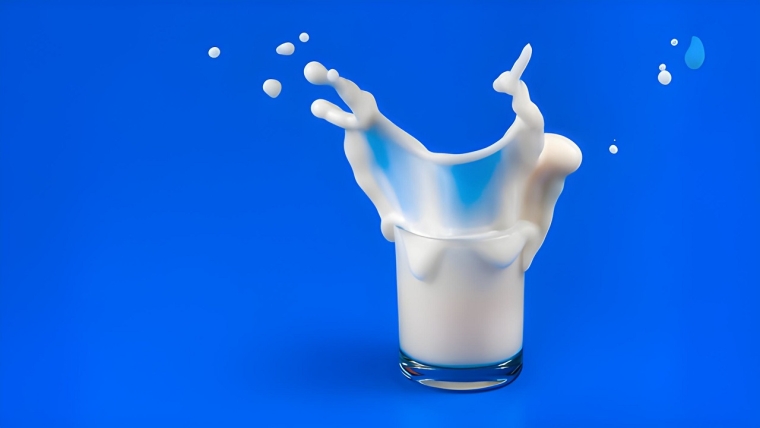
by Eric Frykberg
Further development of synthetic milk could seriously disrupt the entire New Zealand economy, an academic is warning.
The scale of disruption, though, would vary, and there is slow progress at present towards making synthetic milk economic.
Even so, dangers lie around the corner, according to the Professor of Economics at Auckland University of Technology, Niven Winchester.
“Large-scale production of synthetic dairy products – that decreases the price of New Zealand’s largest export commodity – will have a significant negative impact on this economy,” Winchester says.
This issue has arisen after years of analysis which argued that putting grass into a cow is wasteful because a lot of the output is diverted into growth of the animal.
Putting a feedstock such as sugar into a test tube could produce milk which has far less waste, and would have lower environmental side effects.
Synthetic milk produced this way would be a big step beyond existing dairy alternatives such as oat or soy milk. It is produced by precision fermentation, which uses genetic modification of microbes to produce a protein that mimics the protein found in a desired dairy product.
This protein is then combined with other ingredients to imitate the texture and taste of traditional dairy products.
So far, the technology has failed to stop people from drinking milk or munching on cheese which is made in the usual way.
This is proven by cold hard statistics. Global dairy prices have approximately tripled on average since the year 2000. Despite this rise, synthetic milk is still more expensive than traditional milk, according to Winchester’s own analysis.
All this greatly helps dairy exporting nations like New Zealand. As a result, the value of New Zealand dairy exports has risen from $13.7 billion in 2012 to $27 billion in 2025, according to the Ministry for Primary Industries’ annual series of SOPI reports.
But so far might not be so good, if the synthetic milk industry really starts to bite.
Potential impact
To assess its potential impact, Winchester produced some analysis that found that New Zealand’s GDP would fall if synthetic milk became price competitive with dairy milk.
To analyse this further he looked at two different pathways to the future.
One was called a “rigid” scenario, which assumed no land-use change as the dairy industry declined. This would reduce GDP by 0.7%.
The second option was an “adaptive” scenario, which would reduce GDP by 0.5%. The difference stemmed from dairy land being switched to other agricultural uses under the adaptive scenario.
While these numbers might seem small, they are a big share of the dairy industry’s 3.2% contribution to total New Zealand GDP. And while that number might also seem small, the dairy industry’s contribution to the economy is often seen as “good” GDP, in contrast with “bad” GDP, such as the pharmaceutical industry’s expenditure on fighting a preventable disease.
In addition, Winchester’s analysis finds thousands of people would lose their jobs under both scenarios.
Subsidising these jobs would be extremely expensive for the Government.
And switching land use from dairy to other primary industries such as meat under the adaptive scenario would have limited benefit. That would be because the increased meat production would depress its price.
While Winchester’s research analyses rather than fixes these problems, he proposes further scholarly inquiry.
“An important avenue for future research is to explore a land-use change specification that takes into account the increased value of forest land (both production and permanent forestry) from the inclusion of forestry in the New Zealand emissions trading scheme.”
There is little specific response from New Zealand’s agricultural establishment to Winchester’s findings.
The general view is that this matter is still theoretical.
Complex and costly
Dairy NZ is not offering comment on Winchester’s paper, except to cite an existing publication on alternative milks: “Separating Fact from Froth”. This paper starts off by finding that many plant-based milks have less nutritional value than bovine milk.
“There is no comparable study for precision-fermented milks,” it goes on to say.
“But, in theory, it is possible to match the nutritional profile of milk proteins and some of the other components with this method. However, this is complex and, therefore, costly.”
Dairy NZ’s paper also looks at the carbon footprint of synthetic milk, following frequent assertions that the dairy industry is environmentally costly.
But it points out that precision fermentation would need a lot of energy.
In New Zealand, energy might be overwhelmingly renewable, but the same thing cannot be said of overseas countries, which would do the heavy lifting in developing this technology. Furthermore, using sugar as a feed stock would have a big environmental impact.
The study also looks at the economics of synthetic milk.
“Commercial-scale plants are likely to be expensive, and this will make their total cost of production per unit of protein higher than dairy products,” it says.
“Only a handful of start-ups have raised the large amounts of capital required, $US200 million, and the timeline to commercial production at large scale is still years away.”
Meanwhile, the dairy giant Fonterra is not ignoring synthetic milk, while remaining overwhelmingly focused on traditional dairy.
In 2023 it set up a joint venture called Vivici BV, with the Dutch company Royal DSM, to investigate further.
This operation has been running largely under the radar for the subsequent years.
But Fonterra remains committed to the project. Its Chief Science & Technology Officer, Jeremy Hill, says Vivici has received $58.89 million in funding for expansion and the development of new products.
“While dairy nutrition remains the core strength of our Co-op, technologies to create new ingredients can have roles in providing some of the nutrients required by the growing global population,” he says.
Essential nutrients
“Milk is much more than just protein – it provides a very wide range of essential nutrients. However, as global demand for high-quality nutrition grows - and particularly protein - to help meet this demand, we believe new protein technologies can complement our pasture-based dairy rather than compete with it.
“Although scaling such technologies to industrial scale is possible and indeed has been used for years for the production of high value proteins such as enzymes and pharmaceuticals e.g. insulin, numerous challenges have to be overcome for precision fermentation to produce proteins at similar costs to those sourced from in milk.”
The Ministry for Primary Industries is also not commenting on Winchester’s remarks.
But to aid the discussion, it offered up a 2022 report which it commissioned from the think tank Te Puna Whakaaronui.
This report was written in the wake of the famous 300,000 Euro hamburger ($NZ586,000), which was produced entirely in a laboratory.
Despite the negative message from that research Te Puna Whakaaronui found there was a place for alternative proteins. However, their displacement of traditional agriculture would be limited.
“Disruption, if it occurs, won’t be total….the question is how New Zealand stakes out and maintains a value proposition alongside the development of alt-proteins.”
On the question of synthetic milk, it found existing public use of similar products.
One example was synthetic rennet made using precision fermentation. Meanwhile, the American company Perfect Day was making synthetic ice cream and cream cheese.
Te Puna Whakaaronui adds that any attempt to do something like this in New Zealand would have to overcome regulatory hurdles, import costs, and the high economic burden of new start-ups.
13 Comments
This is not really synthetic milk. A critical component of milk is milk fat which the laboratory doesn't seem to be able to produce. Instead they add seed oils. They are basically just making a protein powder. Artificial meat has largely failed and so will this endeavour.
I don't mind if it hurts dairy farming. It will (hopefully) force us to find something more productive to do.
Don't stop there. Tell us more of this productive future.
Sadly statistics would point to farming being more productive than almost any other sector over a lengthy period of time.
Perhaps our best hope was contained at the end of the article. Using synthetic proteins to enhance rather than replace the milk products might be the go.
I've been waiting my whole life for dairy's replacement in the export receipts. Given up.
Dairy and meat production are key industries for New Zealand. Only a small proportion of the workforce are farmers after all. There are a lot of related industries however. What sort of things will be more productive than producing nutritious food for humans?
MikeM7382,
I have no farming connections, but I think you are wrong. Go and look at our trade figures and you will find that-very unusually-we have had 3 months of trade surpluses thanks entirely to our primary industries. We absolutely need the export revenues they produce and that is not going to change anytime soon. What would raise the country's living standards would be a marked improvement in our productivity per capita across the board. I suggest you look at StatsNZ Multifactor productivity by sector and industry 1978-2024 and you will find some revealing facts. Most sectors have a woeful productivity record, with almost all having much poorer productivity than agriculture.
Yes, your analysis is correct. Also, the statement in the paper that the GDP of dairy is of the order of 3.5% is very misleading. Not only does it exclude all off-farm activities, it also excludes all on-farm contractors. In essence, It includes only farm wages and farm profit. It is very unhelpful of the Stats Department to measure agriculture this way, and many people use the statistic without any understanding of what it really measures.
KeithW
I'd disagree Keith.
I'd contend most of them know, it just fits with entire bias so they repeat it.
Half heartedly there is a note about good and bad GDP. Now that's got to do your head in.
"it also excludes all on-farm contractors"
contract milkers and sharemilkers Keith? If so contributor Redcows would not be included in farm GDP
You certainly were correct and despite the obvious ridiculousness may still be. I have a feeling the stats include only one of share milking or contract milking. Only an economist could believe it correct.
Sharemilkers are considered part of agriculture but shearers are not included. Nor are any other contractors that come onto the farm to make silage or harvest grain or apply fertiliser etc.
KeithW
The technology to produce synthetic milk proteins has been around for quite some years. It is a long stretch to commercialise that technology at a competitive price.
If the product is to be the same as bovine milk then it needs to contain multiple types of protein plus milk sugars, fats, minerals and vitamins. This is all technically possible but logistically complex. It is a job that the bovine cow does very nicely all by herself.
My advice to dairy farmers is that there are many more important issues that they might choose to lie awake at night thinking about rather than worrying about synthetic milk.
KeithW
Well put. Cows also produce beef cattle which, being largely minus the sugar, are an even better source of protein, fat, minerals and vitamins for human consumption.
Yes and even if they crack it NZ farmers would be the last to go out of business. And they would be well placed to supply the niche 'natural' market that would always be there.

We welcome your comments below. If you are not already registered, please register to comment
Remember we welcome robust, respectful and insightful debate. We don't welcome abusive or defamatory comments and will de-register those repeatedly making such comments. Our current comment policy is here.